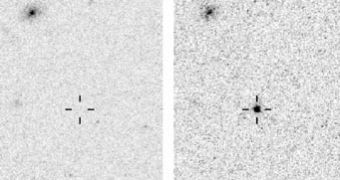Besides providing extraordinary pictures of the universe, Hubble sometimes likes to play with scientists' minds. Recently, it did it again, as the photos it sent showed a sudden light in the middle of nowhere which lasted for about 100 days before fading into darkness again.
Surely, even with instruments like Hubble or better, we can't state for sure that we've discovered every kind of object or phenomenon that goes on out there. Still, astronomers are puzzled: they admit that they've never seen such a thing before. On February 21st 2006, during a project that involved Hubble's monitoring extremely far galaxy clusters in search for supernovae, the telescope was scanning a sector of the 8.2 billion light years away Bootes cluster, called CL 1432.5+3332.8.
At that point, something seemed to become brighter and continued to do so for the next 100 days, reaching its peak at 21st magnitude in 2 near-infrared colors. The following 100 days, the process reversed, until there was nothing left to be seen even at 26th magnitude. Since nothing had previously been spotted there, this means that the object had brightened to 120 times more than its original state during its pulsating firefly-ish episodes.
The astrophysicists called it SCP 06F6. Upon its discovery, scientists like NASA's Stefan Immler compared it with a supernova (12 billion light years away), but such an object only takes 20 days to shine the brightest, while this one took 120. However, given the huge distance and the relativity theory, the universe might stretch the 20-day period to 120 days along the light's travel. But its spectrum doesn't match any known similar phenomenon recorded by the quarter-sky monitoring of the Sloan Digital Sky Survey either. For those of you who understand this, it has "five broad absorption bands between 4100 and 6500 Angstroms and a mostly featureless continuum longward of 6500 Angstroms" (K. Barbary et al.)
Referring to its location, the leader of the study, Kyle Barbary of the University of California, says, "Because we can't see anything we recognize in the spectrum, we can't tell if it's even in the galaxy or in another galaxy." He compares the shining of SCP 06F6 to that of a white dwarf star in Milky Way, a glow that happens when the dwarf star steals matter from another stellar body or from surrounding debris but admits it would be strange and it wouldn't completely explain some things. Also, in an interview for New Scientist, he rejects the 12 billion years away location and places it 1 billion years closer: "If the transient were more distant than this, we would see signs of absorption from intergalactic hydrogen in the blue part of the spectrum", adding that an 11 billion years away supernova's 20-day brightening would only stretch to about 70 days.
Even more contradictions come from the fact that a supernova dims very slowly, a lot slower than SCP 06F6, which faded in the same amount of time it brightened. Also, the fact that it lacks parallax motion suggests that it can't be closer than 130 light years. Parallax, a word for "alteration" derived from the Greek language, describes an apparent displacement or orientation difference of an object that is viewed from 2 different lines of sight. It is measured by the angle (or semi-angle) of inclination between the 2 respective lines. Motion parallax refers to the different viewing positions that can result from an observer's motion.
There you have it: we have a new object that doesn't look like any other of its kind previously observed and is located 130 to 11 billion light years away. Hubble, please be more careful with what you find next time – we still like to consider our science strong, proficient and prepared.

 14 DAY TRIAL //
14 DAY TRIAL //